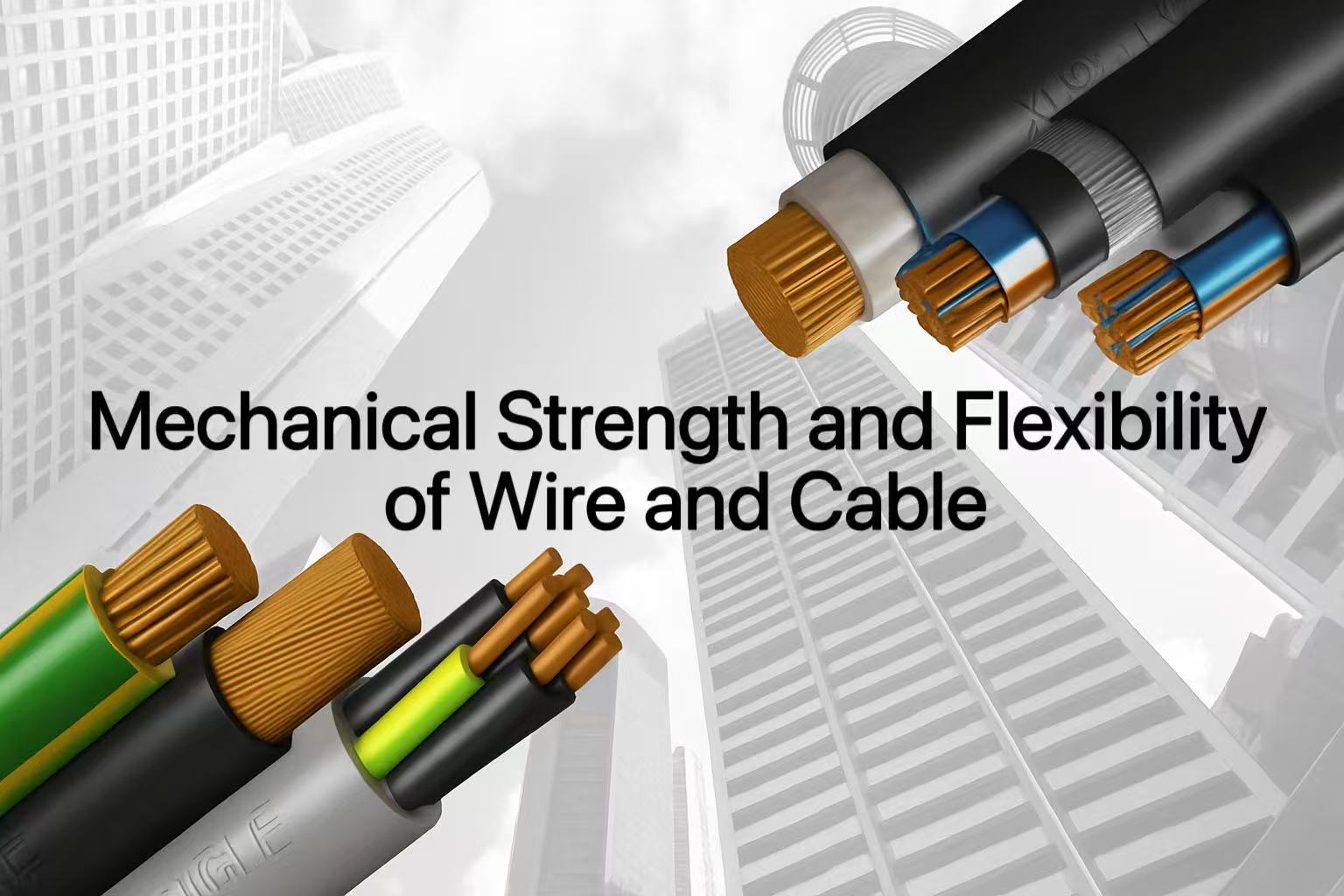Mechanical Strength and Flexibility of Wire and Cable
Cable failures can stop systems and cause major financial losses. Many of these failures are linked to insufficient mechanical strength or lack of flexibility in the cable design.
Mechanical strength and flexibility determine how well a cable can handle pulling, bending, twisting, and crushing without breaking or losing its electrical integrity.
Selecting the right material and structure is not optional—it’s fundamental for long service life, reliable performance, and safety compliance.
Understanding Mechanical Properties in Wire and Cable
Cables experience mechanical stress during installation and operation. Pulling them through conduits, routing in tight spaces, and exposing them to movement all create stress that can lead to failure if the mechanical properties are inadequate.
Key Mechanical Properties
- Tensile Strength: Maximum pulling force before breaking.
- Elongation at Break: Ability to stretch without damage.
- Bending Performance: Ability to flex repeatedly without cracking.
| Property | Description | Typical Range |
|---|---|---|
| Tensile Strength | Force before breaking | 10–25 MPa |
| Elongation at Break | Stretch before breaking | 100–300% |
| Bending Radius | Minimum safe bend radius | 6–15 × cable diameter |
The right balance between strength and flexibility ensures reliability under static and dynamic conditions.
Importance of Flexibility in Cable Design
Cables that are too rigid present multiple issues:
- Difficult installation in compact routing environments.
- Higher risk of insulation cracking in moving systems.
- Reduced service life in dynamic applications like robotics or drag chains.
Why Flexibility Matters
- Installation Efficiency: Flexible cables adapt to tight spaces and reduce bending stress.
- Dynamic Endurance: In automation and robotics, cables move thousands of times. Flexibility prevents conductor breakage.
- Durability: Flexibility reduces internal stress and delays mechanical fatigue.
| Factor | Impact on Flexibility |
|---|---|
| Conductor Design | Stranded = more bendable |
| Insulation Type | TPE, silicone = softer |
| Cable Diameter | Smaller = easier bend |
Factors Influencing Mechanical Strength and Flexibility
Several design and environmental factors determine how cables perform under stress.
| Factor | Effect |
|---|---|
| Conductor Material | Copper = strong & flexible; aluminum = lighter but weaker |
| Jacket Material | TPU = abrasion resistance; PVC = rigid |
| Temperature | Heat softens materials; cold makes them brittle |
Testing Methods for Mechanical Performance
Testing validates whether a cable can handle real-world conditions. Common methods include:
- Tensile Test: Pulling force and elongation check.
- Bending Test: Repeated flexing cycles around a radius.
- Torsion Test: Twisting endurance under load.
- Abrasion Test: Surface wear resistance.
| Test | Purpose |
|---|---|
| Tensile | Pull strength & elongation |
| Bending | Dynamic movement life |
| Torsion | Twisting durability |
| Abrasion | Wear resistance |
Material Selection for High Mechanical Strength and Flexibility
This is where the right choice decides the success or failure of your system. Mechanical performance is not a single property—it is a combination of strength, flexibility, abrasion resistance, and environmental resilience.
Practical Selection Guide
When selecting cable materials, the first step is identifying application requirements:
- Fixed Installation: Requires tensile strength but not extreme flexibility.
- Dynamic Applications (robots, drag chains): Flexibility and abrasion resistance become top priorities.
- Harsh Environments (heat, cold, chemicals): Material must withstand temperature and chemical exposure.
Material Analysis
- XLPE (Cross-linked Polyethylene)
- Strength: High tensile strength.
- Heat Performance: Excellent thermal stability.
- Flexibility: Medium—best for power cables in fixed installations.
- TPE (Thermoplastic Elastomer)
- Flexibility: Very good; ideal for moving systems.
- Chemical Resistance: Good for industrial use.
- TPU (Thermoplastic Polyurethane)
- Abrasion Resistance: Outstanding—perfect for drag chains.
- Flexibility: High, even in repetitive motion.
- Silicone Rubber
- Temperature Range: Extreme heat and cold resistance.
- Flexibility: Excellent but lower abrasion resistance.
Extended Analysis and Decision Factors
When selecting, I always match the cable’s mechanical properties to the installation profile:
- Robotics and Automation: TPU jacket + TPE insulation + fine-stranded conductor = best bend life and abrasion protection.
- High-Temperature Zones: Silicone or XLPE insulation ensures stability under thermal stress.
- Outdoor Exposure: Silicone for UV/ozone resistance; TPU for impact protection.
| Material | Flexibility | Tensile Strength | Abrasion Resistance | Heat Resistance |
|---|---|---|---|---|
| XLPE | Medium | High | Medium | High |
| TPE | High | Medium | Medium | Medium |
| TPU | High | High | Excellent | Medium |
| Silicone | Excellent | Low | Low | Excellent |
Key Takeaways for Engineers
✔ Dynamic motion = prioritize flexibility & abrasion resistance (TPU/TPE).
✔ Static high-heat environments = prioritize tensile strength & thermal stability (XLPE, silicone).
✔ Balance cost vs. performance—overengineering increases cost without added benefit in moderate conditions.
Why Material Selection Matters for Long-Term Reliability
A wrong choice often leads to:
- Insulation cracks under bending stress.
- Premature conductor breakage in motion systems.
- Downtime and costly replacements.
The correct choice guarantees:
- Extended service life.
- Stable performance under stress.
- Lower maintenance cost and compliance with IEC/UL standards.
✅ Final Recommendation:
Choose materials based on mechanical demand + environmental conditions, not just price.
Smart selection = fewer failures, better ROI, and long-term safety.

